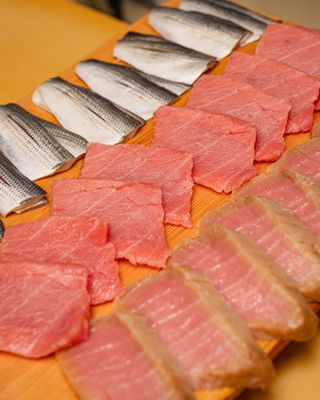Omakase Room by Mitsu
Highlights
Upscale sushi bar featuring traditional Edomae-style omakase.


























"Conversely, chef Tatsuya Sekiguchi of Omakase Room by Tatsu in New York City provides one option: a set menu—which changes frequently—that includes 18 pieces of sushi, with the option of adding supplemental pieces à la carte. Sekiguchi will also tailor the menu to guests as he gets to know them over time. The use of a set menu is important for him though, as it it reflects his philosophy about how he wants the omakase experience to unfold. According to Sekiguchi, providing a set menu allows him to keep prices down, which he believes makes his own restaurant more accessible for people who are afraid of having an exorbitantly priced meal. But it's also important because his cooking is stylistically edomae. Edomae sushi is considered to be the most traditional form, dating back hundreds of years to when fish in Japan's capital city of Edo—now called Tokyo—was sold by street vendors as a snack and was stored in vinegar to keep it from spoiling. Having a set menu allows Sekiguchi the proper time to prepare his fish in the edomae style." - Jacob Dean
"Chef Tatsuya Sekiguchi offers a set menu of 18 pieces of sushi, with optional supplemental pieces. The set menu helps keep prices down and allows proper preparation of fish in the edomae style." - Jacob Dean
"New to Caviar is chef Tatsuya Sekiguchi’s eight-seat omakase bar in the Village. The elite 18-course omakase meal isn’t quite deliverable, but other sushi specials are. The Chirashi Fukiyose ($60) features assortment of fish on a bed of sushi rice, plus a cup of red miso soup. Roll enthusiasts can opt for the FutoMaki ($28), an oversized roll stuffed with tamago, kanpyo, salmon, cucumber, shrimp, anago (sea eel), and shiso leaf. Premium sake bottles, fine wine, and more beverages are also on the menu. Locals can also reserve their meals for pickup via Resy." - Melissa Kravitz Hoeffner
"Raised in a family that ran a restaurant in Japan, the chef initially resisted but ultimately embraced sushi-making after the untimely death of his brother and training from his father, moving from Tokyo to New York to carry on the family legacy. He runs an intimate, eight-seat, 500-square-foot omakase spot focused on pristine sushi and shellfish, sourcing predominantly local seafood alongside imports from Japan. Examples include eel from Maine, orange clam from Connecticut, flounder from Montauk, and Spanish mackerel from North Carolina — the latter of which he smokes to improve its flavor." - Eater Video
"Chef Tatsuya Sekiguchi grew up with this belief of edomae sushi, and still carries it with him today at his newly opened Omakase Room by Tatsu. Back in Japan, he visited the local fishermen to personally pick out the day's offerings for his family's restaurant, Fuku. Now, in New York City, he has taken the contrarian approach to sushi by using 60% local fish—like bonito and Spanish mackerel—instead of pricey Japanese imports favored by most sushi chefs in the city." - Jenny Dorsey



